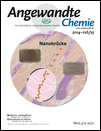Design and Synthesis of Copper–Cobalt Catalysts for the Selective Conversion of Synthesis Gas to Ethanol and Higher Alcohols†
This work was supported by the Center for Atomic-Level Catalyst Design, an Energy Frontier Research Center funded by the U.S. Department of Energy, Office of Science, Office of Basic Energy Sciences under Award Number DE-SC0001058. The authors acknowledge H. Meeldijk, G. Wang and M. Versluijs (UU) for STEM/EDX, UV/Vis and in situ XRD and SEM/EDX measurements and J. P. Holgado (ICMS-CSIC) for XPS experiments.
Abstract
Combining quantum-mechanical simulations and synthesis tools allows the design of highly efficient CuCo/MoOx catalysts for the selective conversion of synthesis gas (CO+H2) into ethanol and higher alcohols, which are of eminent interest for the production of platform chemicals from non-petroleum feedstocks. Density functional theory calculations coupled to microkinetic models identify mixed Cu–Co alloy sites, at Co-enriched surfaces, as ideal for the selective production of long-chain alcohols. Accordingly, a versatile synthesis route is developed based on metal nanoparticle exsolution from a molybdate precursor compound whose crystalline structure isomorphically accommodates Cu2+ and Co2+ cations in a wide range of compositions. As revealed by energy-dispersive X-ray nanospectroscopy and temperature-resolved X-ray diffraction, superior mixing of Cu and Co species promotes formation of CuCo alloy nanocrystals after activation, leading to two orders of magnitude higher yield to high alcohols than a benchmark CuCoCr catalyst. Substantiating simulations, the yield to high alcohols is maximized in parallel to the CuCo alloy contribution, for Co-rich surface compositions, for which Cu phase segregation is prevented.




